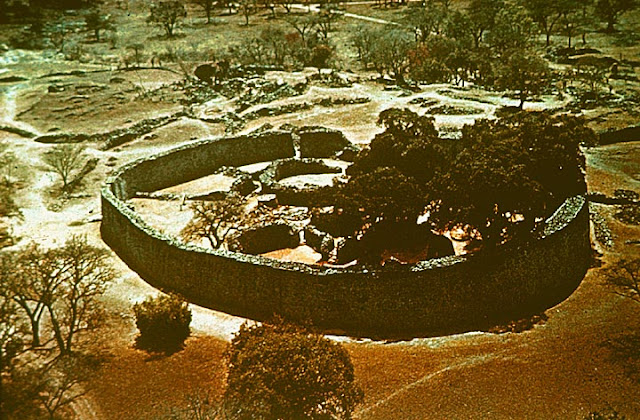Further inland from the coastal cities, other Bantu groups were establishing powerful empires based on one of the region’s most precious and profitable resources: gold. During the 800s, a Bantuspeaking people called the Shona settled in the valley of the Limpopo River in southern Africa. By 1000, they had moved onto an area of rich farmland between the Zambezi and Limpopo rivers. There, the Shona established a thriving empire. Shona Empire The empire that the Shona carved out of the grasslands of southern Africa consisted of numerous Zimbabwe’s, or settlements encircled by large stone walls.
The term Zimbabwe comes from a Shona phrase, dzimba dza mabwe, which means “houses of stone.” The ruins of about 150 such structures are scattered throughout the present-day southern African countries of Botswana, Mozambique, and Zimbabwe. Great Zimbabwe the largest of the Shona settlements was known as Great Zimbabwe. It was the center of the Shona empire.
The city and its surrounding area covered more than 100 acres and had a population of 10,000 to 20,000 people. Geography played an important role in Great Zimbabwe’s rise. The region was surrounded by huge plains that the Shona used for farming and cattle raising. Great Zimbabwe was also located near key trade routes.
There are three main sections of Great Zimbabwe: The Valley Ruins, the Hill Complex, and the Great Enclosure. The Great Enclosure is the largest and most significant of these sections. Archaeologists think that the Great Enclosure was used as a home for kings and queens. From the air, the Great Enclosure looks like a giant necklace. Its outer wall is about 820 feet around and rises as high as 36 feet. An inner wall runs along part of the outer wall.
The two walls form a narrow passageway that leads to a 33-foot-high cone-shaped tower. The tower’s purpose remains a mystery. At one time, the enclosure contained elaborate buildings constructed of daga brick made from mud or clay. Shona builders cut stone blocks for the Great Enclosure’s walls from the granite hills around the city. They carved the blocks with such precision that nothing was needed to hold them in place. Many of the Great Enclosure’s walls are as smooth as a modern brick wall. The most elaborate walls probably date from the 1300s and 1400s.
Great Zimbabwe the largest remaining section of Great Zimbabwe is called the Great Enclosure. Its maximum diameter is about the length of a football field, and its walls are about 36 feet high. 1 Scholars believe kings and queens lived in the Great Enclosure, while farmers and workers lived outside. 2 A passage between the outer and inner walls leads to a 33-foot cone-shaped tower.
Historians speculate that it may have had religious purposes. Gold, Trade, and Decline Great Zimbabwe became an influential center of wealth and power due to the trade routes that passed through the city. The key product that traveled along these routes was gold. Gold was one of the main goods traded between Africa and the lands of India and China. Great Zimbabwe did not produce gold. However, it stood between the gold-producing regions to the west and the trading cities along the eastern coast. As a result, Great Zimbabwe’s leaders could tax those traveling the routes. They could also demand gold from the region’s less powerful leaders.
The city became the center of the international gold trade. Scholars estimate that at its peak, travelers carried more than 2,000 pounds of gold through Great Zimbabwe every year. During the 1400s, Great Zimbabwe began to decline. Some historians say that drought and the overuse of grazing land caused a resource shortage. Others argue that people left to take advantage of shifting trade networks. Whatever the reason, Great Zimbabwe was abandoned by 1500.
Product You May Interested
Crush Food Cravings with Odd Water Hack and Melt 62lbsFlavor Pairing Ritual Supercharges Women’s MetabolismsThe best Keto Diet ProgramUnlock your Hip Flexors, Gives you More Strength, Better Health & All-Day Energy.21 Days Flat Belly Rapid Weight Loss SystemFan Victor – The Ultimate Fantasy Sports Plug-in7 Instant Confidence Technique with Women Program
































